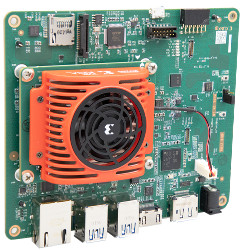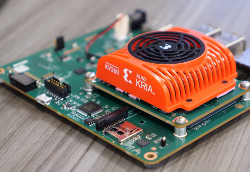Xilinx launches UltraScale+ based SOM and $199 dev kit with AI extensions
Apr 29, 2021 — by Eric Brown 2,204 views Xilinx has launched a “Kria K26 SOM” that runs Linux on its Zynq UltraScale+ MPSoC, plus a $199 “Kria KV260 Vision AI” kit with GbE, HDMI, DP, PMOD, CSI, 2x IAS, and 4x USB 3.0. Xilinx is supporting the products with a new edge AI app store.
Xilinx has launched a “Kria K26 SOM” that runs Linux on its Zynq UltraScale+ MPSoC, plus a $199 “Kria KV260 Vision AI” kit with GbE, HDMI, DP, PMOD, CSI, 2x IAS, and 4x USB 3.0. Xilinx is supporting the products with a new edge AI app store.
For years, third party vendors have been developing compute modules and SBCs built around Xilinx’s Arm/FPGA hybrid Zynq 7000 and quad -A53 Zynq UltraScale+ MPSoC system-on-chips, most recently including Topc Embedded’s UltraScale+ based Miami MPSoC Plus module and Florida Plus kit. Xilinx itself has limited its homegrown hardware support to high-end evaluation kits, such as its $11,995 Zynq UltraScale+ RFSoC ZCU216 Evaluation Kit. Now, for the first time Xilinx has launched its own compute module line, called Kria, as well as a $199 dev kit.


Kria K26 SOM (left) and Kria KV260 Vision AI Starter Kit
(click images to enlarge)
The Kria K26 SOM module runs Xilinx’s Yocto-based PetaLinux on a custom version of the Zynq UltraScale+ MPSoC called the XCK26, which offers Xilinx Vitis AI technology. The XCK26 “has been configured for enhanced acceleration of vision AI applications,” says Xilinx. The SoC and module will soon be certified for Ubuntu, which is a first for the Zynq products (see farther below).
You can order the Kria K26 SOM now on the $199 Kria KV260 Vision AI Starter Kit, which ships in June. Commercial and industrial versions of the module will be available later this year, priced at $250 or $350 in individual units, respectively. The SOM and kit support edge AI applications including smart camera, embedded vision, and other security, retail analytics, smart city, and machine vision applications.
— ADVERTISEMENT —
We did not see a specific UltraScale+ model name, but the commercial and industrial Kria K26 SOM models offer 256K system logic cells, 245 I/Os, and a VPU, which suggests they are equivalent to a standard, mid-range UltraScale+ ZU5EG. The XCK26 supports 1.4-TOPS AI compute power.
Since the KV260 kit with the built-in kit version of the module costs less than the commercial module on its own, it is likely a lower-end EG module with lesser FPGA capability. All these UltraScale+ models provide the same Arm block, with 4x 1.2GHz Cortex-A53 cores, a 667MHz Mali-400 MP2 GPU, and dual 600MHz Cortex-R5 MCUs. (In other Zynq news, in March Xilinx announced a super small and cost-optimized, dual-core ZU1 UltraScale+ model, which the Xilinx UltraScale+ page (PDF) lists as having 81K logic cells.)


Kria KV260 Vision AI Starter Kit (left) and block diagram
(click images to enlarge)
The other major news is that the Kria K26 SOM is supported with a new Xilinx app store for edge AI applications. The Hackster.io story that first reported on the Kria K26 SOM and KV260 kit last week considered the app library to be even more significant than the hardware (see farther below).
The Kria news appeared in early April a few days after AMD and Xilinx shareholders voted to approve AMD’s proposed $35 billion acquisition of Xilinx, one of the largest high-end FPGA vendors along with Intel’s Altera unit. The deal is expected to pass regulatory approvals and close by the end of the year.
AMD appears to be especially interested in Xilinx’s upcoming, 7nm Versal ACAP (adaptive compute acceleration platform) Arm/FPGA hybrid processors. The Versal line includes an AI Core mode model with a programmable AI Engine. Versal works with a new Vitis unified software platform that is backward compatible with Zynq UltraScale+.
Also referred to as Xilinx Vitis AI, this appears to be the source of the AI extensions on the Kria K26 SOM’s UltraScale+ like XCK26 SoC. iWave offers Xilinx Vitis AI support on its UltraScale+ based iW-RainboW-G36S Corazon AI Pico-ITX SBC.
With the AI/ML focused Kria K26 SOM and Kria KV260 kit, Xilinx is perhaps following the lead of Nvidia’s success with its Jetson modules and recent low-cost, maker-oriented dev kits such as the Jetson Nano Developer Kit. Google is doing something similar with its more fully open source, maker focused Coral Dev Boards and related products that expand access to its Google Edge TPU chip.
Kria K26 SOM
The Kria K26 SOM, which measures 77 x 60 x 11mm with the heatspreader, is equipped with 4GB DDR4 and 16GB eMMC. There is also a TPM 2.0 chip bootable 512Mb (possibly MB) QSPI flash, and 3x LEDs.

Kria K26 SOM detail views
(click image to enlarge)
The module’s dual 240-pin B2B connectors support high-speed I/O including 4x “Tri-mode” Gigabit Ethernet controllers, PCIe Gen2 x4, 2x USB 3.0, SATA 3.1, and DP. Lower-speed I/Os include 2x USB 2.0, 2x SD/SDIO, 2x UART, 2x CAN 2.0B, 2x I2C, 2x SPI, and 4x 32-bit GPIO.
The Kria K26 SOM supplies FPGA-driven transceivers including 4x 6Gbps GTR transceivers and 4x 12.5 Gbps GTH transceivers with PCIe Gen3 x4, SLVS-EC, HDMI 2.0, and DP 1.4. The module runs at a typical 7.5W and 15W maximum. The upcoming commercial model has a 0 to 85°C range, and the industrial model can handle -40 to 100°C.
Future Kira SOMs will include a cost-constrained model and a higher performance model with “more real-time compute capability per Watt.” The latter is possibly based on the upcoming Versal ACAP SoC.
Kria KV260 Vision AI Starter Kit
The $199 starter kit for the Kria K26 SOM measures 140 x 119 x 36mm and features an orange fan+heatsink thermal solution that looks a bit like the hind end of a Husqvarna chainsaw. Major features include a microSD slot and single GbE, HDMI 1.4, and DP 1.2a ports.


Kria KV260 Vision AI Starter Kit detail view (left) and full kit with both power and basic accessories
(click images to enlarge)
The Kria KV260 Vision AI Starter Kit is further equipped with a 12-pin PMOD connector for PMOD add-ons plus a micro-USB debug port and 4x USB 3.0 ports. Other features include a 12V DC jack, JTAG, and a fan power switch. In addition to the TPM chip on the module, the dev kit ships with hardware root of trust functionality for secure boot.
Up to 8x cameras are supported via the USB and GbE ports, as well as a MIPI-CSI connector that supports the Raspberry Pi Camera and dual IAS MIPI sensor interfaces. The SBC uses On Semi’s 13-megapixel AP1302 ISP and an On Semi IAS sensor. One possibility is On Semi’s ARX3A0 sensor.
The $199 price does not include the power supply and adapter accessory kit, which adds $25. A $59 accessory pack adds cables, a preloaded microSD card, and an IAS camera module (see image above).
Vitis stack, Kria App Store. and Ubuntu support
The Kria KV260 Vision AI Starter Kit ships with a pre-built, PetaLinux based stack that incorporates the Vitis unified software development platform and libraries. The software is designed to ease the path for non-FPGA experts.
The stack includes production-ready, turnkey vision accelerated applications that “eliminate all the FPGA hardware design work and only require software developers to integrate their custom AI models, and application code,” says Xilinx. Developers can optionally modify the vision pipeline using familiar design environments like TensorFlow, Pytorch, or Caffe frameworks, as well as C, C++, OpenCL, and Python programming languages.
Users can then download additional AI/ML apps from the new Kria embedded app store, an extension of the Xilinx App Store for datacenter apps. The apps are packaged in Linux deployment frameworks for easy installation and OTA updates.
There is a free evaluation trial for the app store, and all Xilinx apps are free and open source. Free and commercial third-party apps will also be available. Initial apps include Smart Camera, AI Box with ReID, and Defect Detection from Xilinx, as well as AI Box for Auto License Plate Recognition (Uncanny Vision), and Denali 3.0 HDR Image Signal Processor (Pinnacle Imagine Systems).
Nvidia recently announced something similar by launching an extended NGC catalog of Jetson ready, pretrained AI models as part of its Nvidia TAO platform. As with Vitis, Nvidia TAO aims to ease the learning curve for developers tackling AI.
Other developer resources for the Kria SOMs include tutorial videos, training courses, and “a vast ecosystem of providers offering accelerated applications, design services, and more.” There is no indication this is an open hardware project, however.
Finally, Xilinx and Canonical have collaborated to provide Ubuntu for the Kria K26 SOM. Initial images are expected in July.
Further information
The commercial-grade Kria K26 SOM is available for order for $250 and will ship in May and the industrial-grade model can be ordered for $350 and will ship sometime this summer. The Kria KV260 Vision AI Starter Kit with the Kria K26 SOM with the presumably scaled down version of the UltraScale+ based XCK26 SoC is available for $199, with shipments due in 8 weeks (June). A power supply and adapter accessory kit costs $25 and an accessory pack adds $59.
More information may be found in the Xilinx announcement and the Kria KV260 shopping page and Kria KV260/Kria K26 SOM product page, which offers links to the commercial and industrial Kria K26 SOM shopping pages.

Please comment here...